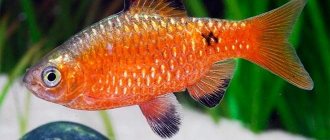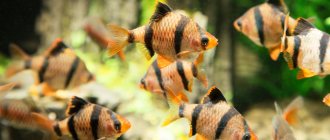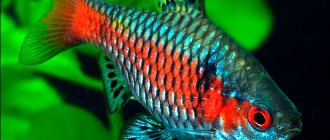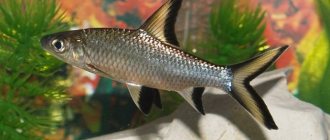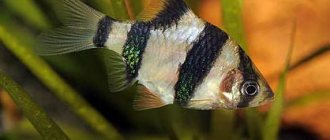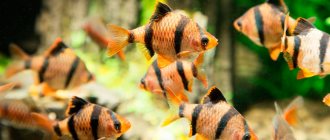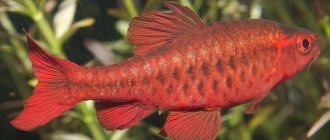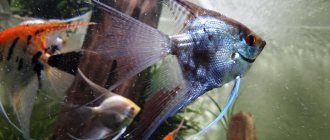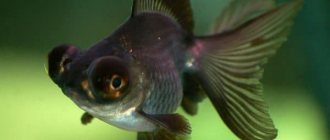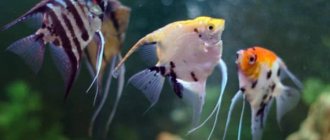Barbs, or simply “barbels,” are ray-finned fish from the carp family, which can often be found in the aquariums of amateurs and professionals. These exotic creatures have a wide range of habitats and many varieties. And any aquarist can choose the pets that he likes - bright or pale fish, large or small, calm or cocky. These are all barbs - their diversity is impressive, the main thing is to learn the characteristics and properly care for your charges.
Origin and habitat of barbs
Under natural conditions, these aquatic inhabitants can be found in water bodies in Africa and Southeast Asia. Compared to other wild fish, barbs are not large in size. The smallest of them grow up to 5-7 cm in length, but individuals of some varieties reach 25-30 cm.
Today, barbs for aquarium keeping, caught in nature or bred on fish farms, are widely used. In addition, there are a number of breed varieties that were obtained through selective breeding. Large-sized individuals are becoming less and less common; more compact representatives are more often released into aquariums.
All barbs have a Weberian apparatus, which provides the fish with acute hearing. These fish are relatively unpretentious and easy to breed. And if you provide them with suitable conditions and neighbors, they will not show aggression or discontent. Only the owner’s mistakes can lead to the fact that barbels begin to offend other inhabitants, and to avoid this, you should become familiar with the characteristics of the fish before they are released into the tank.
Barbs swim very quickly, they are active and mobile, which means they need space for movement and maneuvers. They will not swim imposingly, slowly, freezing in place; this is not in the nature of barbels. These inhabitants always seem to be looking for something, rushing one after another and flickering in one part of the aquarium, then in another.
Thanks to such dynamic behavior of their charges, it is not boring to watch them; the playfulness of barbs attracts and makes you linger for a long time at the aquarium. At the same time, keeping these fish is easy; both beginners and experienced aquarists can keep them. Longhorned beetles are the inhabitants of the timid dozen, so you need to be careful when choosing company, especially for large-sized individuals. For example, they are able to gnaw the fins of large cichlids, gourami, and goldfish.
General information about barbs
Barbs belong to the class Ray-finned fish, family Cyprinidae, genus Barbus.
There are more than 200 species of barbs in the world, 50 of which are popular among aquarists. A distinctive feature of these fish is the absence of jaw teeth and the presence of pharyngeal teeth. Most aquarium inhabitants are native to Africa and Southeast Asia. All barbs require a water temperature of +20 to +25°C and a neutral pH. Weekly water changes should be 20%. Large species of barbs are more peaceful than small ones and can be kept even with slow neighbors.
Different types of barbs
There are more than one and a half dozen species of barbs, each of which enjoys a certain popularity. Despite this diversity, all breed representatives have similar external characteristics:
- elongated, slightly elongated body;
- bilobed tail;
- antennae located above the upper jaw.
Females are larger in size and have a large, rounded abdomen. And males, although inferior in size, stand out for their brighter, more intense color. Barbs are useful for an aquarium - they are omnivores and are excellent at collecting uneaten remains from the ground. You can find many breed varieties on sale.
Green barb
The most popular representative of the species that can be found among aquarium inhabitants. Its homeland is Southeast Asia, where these fish live in streams, small rivers and flood fields.
The green barb has an elongated body, the back line is curved, and there are antennae at the mouth. The abdomen of the fish is whitish; in females during the spawning period it becomes red-orange. The sides are painted in greenish and golden tones, with short, black transverse stripes on them. There is a black spot at the base of the caudal fin. The scales are framed by a dark border, which creates an interesting pattern that looks like a fine mesh.
The size of females does not exceed 9 cm, males grow no more than 7 cm. In nature, you can also find larger individuals of this species, longer than 10 cm, but in an aquarium the fish are usually smaller. Barbels swim in the lower and middle parts of the reservoir, so it is not recommended to plant the bottom with dense vegetation. It is better to purchase several individuals of this breed - up to 10 pieces, so they will adhere to the hierarchy and behave calmly, without annoying their neighbors.
Cherry barb
Representatives of this species are cute, calm fish that coexist peacefully with almost all aquarium inhabitants. And they got their name because of the bright color of the males, which they acquire during spawning.
Cherry barbs are popular among aquarium enthusiasts due to their beautiful appearance, unpretentiousness and vitality. Fish of this species are smaller than green barbs, their length usually does not exceed 5 cm. Their body is oval, the sides are covered with reddish or yellow scales. The fins are painted the same color, but in a brighter shade.
Like other "barbels" there is a peculiarity - 2 antennae located on the lower jaw. There are stripes of a reddish tone on the upper part of the iris of the eyes. Males, as is customary in the breed, are smaller and brighter than females. Females have a light yellow belly, large and rounded, and have two dark stripes on the dorsal fin.
Cherry barbs do not require complicated care, but if they live in poor conditions, their color becomes dull and inexpressive. These long-lived barbels live on average for at least 7 years. Of course, this primarily depends on the quality of food and the environment. Fish can be called timid and modest; they do not offend their neighbors, and they themselves prefer to hide behind stones and snags. Therefore, it is important to design the tank, taking into account the preferences of its inhabitants.
It is better to start a flock of 5-8 individuals; for such a number of fish, a 30-40-liter aquarium is enough. The cherry barb feels more comfortable in semi-darkness, so it is advisable to use dark ground material.
Barbus or puntius five-stripe
This species is more common than others; almost any pet store offers these fish for sale. The high popularity is due to the original coloring and peculiar behavior of these individuals. Five-striped barbs are very smart; some owners play with their pets by highlighting a strip of light with a flashlight. The fish react to the light beam and follow it.
The body of the puntius is oval in shape, flattened on the sides, the back is arched. Individuals are painted in a golden-orange hue, with clearly defined transverse stripes of black on the sides. The fins are reddish in color, the belly is lighter than the rest of the body.
Representatives of this species are not large in size; they are smaller than most barbs and rarely reach a length of 5 cm. The average life expectancy of puntius is 4-5 years.
These aquarium inhabitants are active, playful, but shy. They definitely need to equip shelters - grottoes, plants, large stones. It is advisable to keep a flock of 5-10 fish. They will stay in the lower layers of the water, rarely emerging into well-lit areas.
Five-striped barbs are voracious, so it is important not to overfeed them. The diet should include bloodworms, coretra, tubifex, lettuce, spinach, scalded with boiling water. Experienced owners recommend giving these fish a fasting day once a week, and giving food 2-3 times a day in small portions.
Barbus or fiery puntius
In their natural environment, these fish can be found in shallow bodies of water where there is slow current or standing water. Fire punts have an unusual, rich color. Their body is olive in color, and their belly and sides are reddish and golden. The fins have a black border. Males are noticeably smaller than females; female fish have pale fins, the main color varies from gray-brown to dark yellow.
Fire punts have an excellent appetite and good-natured disposition, and besides, care is not difficult even for beginners. For fish you need a 50-55 liter tank with a lid, low lighting and soil made of medium-sized pebbles. Representatives of this species also need secluded places, snags, and stones. They are unpretentious in food and can eat almost any store-bought food.
Mossy barb or “mutant”
This is one of the varieties of four-striped barb, representatives of which can often be found on sale and in hobby aquariums. These fish appeared on the territory of the USSR in the 80s of the last century; they were brought from Czechoslovakia. As a separate species, mossy barbs resulted from mutagenesis of Sumatran barbs.
For a long time, this variety was not perceived as individuals of a separate subspecies and was not selected, being perceived as a marriage. This situation persisted until aquarists from Germany became interested in these unusual fish, and they began to purchase them in large quantities. Thus, Sumatran barbs gained popularity and wide distribution.
Individuals of this species have a bream-like body, their length does not exceed 5 cm. The back is arched, the stomach is flattened. Unlike most barbs, there are no dark stripes in the color. During the process, the number of stripes on the fish changed, spots and dark dots appeared on the body. The second and third stripes became significantly shorter, and in some individuals they completely disappeared.
The color of their scales is greenish-black or dark blue. Part of the gill arches, nose, dorsal and caudal fins, as well as the abdomen are pale silver. Males have short antennae, while "ladies" do not. Females are larger and their coloration is much less showy.
Sumatran barbs are one of the most unpretentious aquarium inhabitants; it is with them that you can start getting acquainted with the aquarium business. They are peaceful and therefore suitable for keeping in communal tanks. These fish develop great speed, so they need a spacious aquarium. It is best to choose an oblong container for them. And you should not clutter the lower water layers with decor or vegetation.
"Sumatrans" are tenacious and capable of living in a wide variety of conditions, but they will still be healthier and happier if they are in clean water containing enough oxygen. These fish do not require twilight; you can make the lighting brighter, and send a flock of neons to them as company. Such cheerful and colorful inhabitants will make the aquarium environment very colorful.
You can plant Limnophila, Sagittaria in the tank, and let duckweed and Riccia spread across the surface. Mutants are fed several times a day, in small portions.
Barbus linear
The second name is four-line barb. These are fish with an elongated body on which a high, pointed dorsal fin is located. A distinctive feature of the variety is the presence of 4 dark blue stripes that run from the head to the tail. The tail is round in shape, has a notch and a border in the form of a black stripe. The dorsal and anal fins have no pigmentation and are transparent.
The length of the fish varies from 8 to 10 cm, males are smaller than females. They are mobile and active, but sudden sounds and movements make them hide. Like other barbs, it is advisable to keep linear barbs in flocks of 5-10 individuals. If the pet lives in an aquarium without any relatives, its behavior will deteriorate, the barb will pester other inhabitants and behave very aggressively.
Linear barbs swim unusually with their heads slightly tilted down. They can often be found in the bottom area, away from bright lighting. Representatives of this species need a tank with a volume of 80-100 liters, but cramped conditions make the males angry, and they begin to offend the females.
It is better to use sandy materials as soil, and it is advisable to equip the aquarium with a biofilter. You can feed the linear barb with the same food as other fish of this breed. You can diversify your diet with algae and dandelions scalded with boiling water.
Fish of this species are excellent cleaners; they love to pick up food particles from the ground, ensuring the bottom is clean. If the owner wants to get offspring, he will have to equip the pets with a separate spawning area. 15 cm of water is taken into the container; care should be taken to ensure low aeration and a certain water temperature - 26°-28°C.
Black barb
A popular variety of barbs among Russian aquarium enthusiasts. It appeared here in 1954, and until now interest in these fish has not diminished. The original feature of the black barb is its extraordinary color. The fish has a beautiful, oval body, the main color is pale yellow, there are black stripes along the body, one of them extends to part of the caudal fin.
When females prepare for spawning, they acquire a pronounced dark color, while males become dark red or completely black. Black barbs feel most comfortable in a flock; the largest individuals reach a length of 7 cm. They get along well with equally small and peaceful neighbors. You can also add larger fish to them, but not too aggressive ones.
It is a pleasure to watch representatives of this species; they are playful, active, love to communicate with their fellow creatures and swim carefree around the aquarium. In order for the inhabitants to maintain a positive attitude, it is necessary to take care of suitable conditions: water temperature within 20°-24°C, high-quality aeration and filtration. To prevent fish from getting carried away with eating algae, it is necessary to include plant foods in their menu.
Scarlet Barb
This guest arrived in Russia from India, and since the fish first appeared in Odessa, they began to be called “Odessa barbs.” Individuals of this variety have an oval-shaped body, flattened on the sides. Their belly is light, the back is greenish, and the sides are silvery. The scarlet fish are nicknamed because during the spawning period the males turn intense red.
Like all barbs, these fish are easy to keep; if you provide them with comfortable conditions, they will delight with their perky appearance and playfulness. Scarlet barbs are mischievous and can tear off the luxurious fins of their neighbors. Therefore, you should not place them in the same aquarium with fish that have long, wide fins and a tail.
To make the fish look more impressive, it is worth using dark soil and providing the upper part of the water with bright lighting. It is important that the tank is aerated and filtered regularly.
Barbus Denisoni
Another fish from Indian waters, here it is found in the Manimala River. The barb variety was named after Sir Thomas Denison, who was formerly the Governor of Madras. The Denisoni barb has a lanceolate and oblong body that is silver in color with a golden tint or gold and silver.
There is a black stripe running down the middle of the body, and another bright red stripe located from the nose to the dorsal fin. The back of the fish is covered with olive-colored scales; the dorsal fin also has a red stripe resembling a ray. The tail of this barb is fork-shaped, decorated with yellow and black stripes.
There are practically no sexual differences in individuals of this species, except that when spawning approaches, the female’s abdomen noticeably rounds. The fish are not small, the size of aquarium inhabitants of both sexes is 9-11 cm.
Denison barbs are not recommended for inexperienced hobbyists, as they require special conditions and care. Even a small flock of 5-7 fish needs a 200-liter tank, no less. It is desirable that aquarium conditions be as close to natural as possible. The container must be populated with unpretentious vegetation and care must be taken to ensure that there are no inorganic compounds in one environment.
Barbus the clown
Large fish from the carp family, even in an aquarium growing up to 15 cm in length. Naturally, they need a large, spacious tank. It’s not for nothing that clowns got their name; their color is impressive: the back is red or red-brown, there are black and blue spots on the sides, and the fins are red. More intense colors are found in males, which are smaller in size than females.
Unlike other representatives of the species, clown barbs can live in pairs, although they also feel great in a flock. During the spawning period, gentlemen must be kept separately from females for 14 days. These fish are not picky when it comes to food, but it is recommended that they be given food with plant ingredients. Otherwise, these inhabitants will begin to gnaw away the vegetation with pleasure, not giving it a chance to look beautiful.
Sumatran barb
The homeland of these fish is Sumatra and the island of Borneo; a few Sumatran barbs can be found in the reservoirs of Cambodia and Thailand. Today, their habitat has expanded significantly; they live in Singapore, Australian, Colombian and American rivers.
The Sumatran barb has a short body, of decent height, with characteristic flattened sides. Its structure is reminiscent of crucian carp, but the main tone of the scales is yellowish, with pronounced silvery tints. The specific feature of these fish is their four “signature” black stripes, which are located across the body. The outermost stripe is located near the caudal fin, the front one runs across the eyes. The end of the dorsal fin is bordered by a bright, intense red stripe.
In larger females, the color of the scales is more faded, the stripes do not stand out so sharply, and the abdomen is large and rounded. There is a subtle point on the head. In aquarium conditions, Sumatran barbs do not grow longer than 5-6 cm. In good conditions, their life expectancy is approximately 5-6 years.
Barbus Shark
This representative of a large carp family lives in Malaysian reservoirs, as well as in Cambodia, Thailand, and the islands of Kalimantan and Sumatra. They were brought to Russia in the 70s of the last century. In their natural environment, shark barbs grow up to 35 cm, while aquarium-kept specimens are much smaller, reaching a maximum of 20 cm.
Fish of this species look very impressive. They have a silver-gray, large body, flattened on both sides, large eyes and mouth, large scales, and have a mirror effect. The pectoral fins of the shark barb are colorless, and the dorsal and caudal fins are bright yellow, they are decorated with a black border.
Since these aquarium inhabitants are of decent size and love to swim quickly and frolic, they need a large tank, at least 150-200 liters. In a darker pond, these fish stop growing. It is also worth taking care of the safety of these fish, as they are very jumpy. The aquarium should be equipped with a special lid, thanks to which you can avoid trouble.
Shark barbs have a weak digestive system, so their diet should consist only of special food suitable for these fish.
Compatibility of barbs with other fish in the aquarium
Good neighbors for barbs
Botsiya
The peaceful and nimble clown fish is similar in character and behavior to the barb and therefore gets along well with it. To achieve greater harmony, there should be several combatants. A single loachfish becomes aggressive over time. And Sumatran minke whales with loachfishes also have the same scale color and habitat, so they get along and look beautiful together.
Swordtails
Fast and energetic swordtails have an active behavior and are not inferior in speed to striped predators. The only irritating factor is the large fins, which can annoy neighbors. This problem can be solved by placing additional plants and shelters in the aquarium. During a chase, swordtails easily escape their pursuers.
Danio rerio
Schools of zebrafish are in constant motion and busy with their own affairs. They do not have long fins that can disturb their neighbors. Their fast movement helps to avoid contact and quarrels.
Gourami
Large and active gourami are endowed with a calm disposition, which helps to get along with fidgets. Of all the species, cherry gouramis live best. They begin to accustom them to each other by placing them with young fish hooligans.
Watch an interesting video about barbs and their compatibility.
Catfish
Catfish and barbs live on different tiers of the aquarium. They share nothing and get along well. Catfish are bottom-dwelling fish, while stripers live in the middle and upper layers of water. These two types of aquarium inhabitants do not conflict.
Pecilia
Barbs and platies can get along in the same aquarium. The only drawback is the appearance of offspring in these viviparous fish, which will quickly be eaten.
Compatibility of different types of barbs
Barbs have excellent compatibility with each other. Schubert's peaceful species gets along well with its relatives, as well as other species of fish. The Sumatran species has the hardest time finding neighbors. Sumatran, cherry and fiery species will get along with each other. The five-lined one will take root with the fiery one, and the red-lined one with the Sumatran one.
Negative compatibility
Unfortunately, barbs do not get along with many fish. These varieties include:
- Angelfish are phlegmatic and regal fish, whose slow and graceful movements make the striped bullies irritated and want to nibble on the angelfish's fins. The latter, by the way, are also put off by the fussiness and energy of their neighbors.
- Bettas - these fish are much more cocky than minke whales, and fights cannot be avoided if they live together. What makes the situation worse is that bettas have luxurious and long fins.
- Guppies are bad neighbors for minke whales. The presence of lush fins on guppies will serve as a clear reason for neighbors to gnaw them.
- Lalius are aquarium fish characterized by their modest character and slowness. Considering the timidity of laliuses, energetic striped neighbors will bring the fish to nervous stress.
- Astronotus are large, aggressive and capricious fish, for which minke whales themselves will become a victim and an object of attack.
- Cichlids are predatory and intelligent aquarium fish that will happily hunt their striped neighbors and drive minke whales.
Barbs are energetic and mischievous fish that are not averse to fooling around in an artificial pond: chasing neighbors, plucking greens and playing tag. However, it is the mobility of the fish that attracts aquarists - watching a flock of striped pets is fascinating for both adults and children. The main thing when moving into a species aquarium is to follow the rules of general keeping with other fish, and take into account the compatibility of phenotypes.
Barbs and shrimps
They must not be combined under any circumstances! Shrimp have a small chance to survive only if Java moss is planted at the bottom, otherwise... After breakfast and lunch, barbs recheck every grain of sand in search of food. Shrimp are a wonderful delicacy for them.
True, if there is a good flow in the aquarium and there are a lot of plants, then you can try planting them together. However, this is more of a lottery than a proper neighborhood.
Barbs and crayfish
These pets are “multi-level”, that is, they live in different layers of water. In addition, the fish are very playful, and here you need to worry about both crayfish and barbs. In general, they do not conflict, but if they cross, dangerous situations can occur. A barb that is gaping in the area of action of the crayfish runs the risk of being caught in its tenacious claws. Cancer, in turn, becomes defenseless after molting, until the shell has regained its former density.
Barbs and snails
In this case, opinions differ: some fans claim that the fish eat up the inhabitants of the shells completely and mercilessly. Others note their peaceful proximity. On the one hand, barbs can destroy the reel population. On the other hand, even ampullaria often suffer from these aggressors. There is an opinion that if there is abundant vegetation in the aquarium, snails manage to survive successfully.
Plants
There should be a lot of vegetation in an aquarium with these fish. But they like to pluck “tender” plants because of their temperament, that is, just like that. Some aquarists, so that the plants have time to produce at least small shoots, throw a lettuce leaf into the aquarium to calm the pets’ appetite.
Tender plants include:
- Vallisneria
- cabomba carolina
- water cabomba
- cabomba forked
- limnophils (ambulia)
Barbs of any type should be kept in a planted aquarium.
Live ones are preferred, but plastic ones can also be used. It is better to plant hard-leaved ones with barbs, for example:
- anubias
- cryptocoryne
- fern
They do not like such plants and consider them tasteless. In addition, they are difficult to chew.
Features of aquarium keeping barbs
Despite the many breed varieties, there are a number of general recommendations for the care and maintenance of barbs:
- the minimum volume of an aquarium for a flock of small barbs is 50 liters;
- water temperature – fish of this breed adapt well to various conditions and even tolerate temperatures of 17°C well. However, this indicator should not go beyond 19-25C;
- acidity – from 6.5 to 7.5 pH;
- hardness – 4-10;
- barbs like “old” water and intense flow, which can be provided by aeration or a pump;
- It is necessary to filter water regularly;
- weekly water changes are needed - on average by a quarter of the total volume;
- It is better to keep small barbs in a flock of up to 10 individuals; larger representatives can live alone or in pairs;
- the smaller the barbels, the shorter they live - the life expectancy of small barbs is from 3 to 5 years, for larger barbs - up to 8-10 years;
- representatives of small species are more unpretentious in maintenance, while large fish are more demanding;
- It is better to use dark-colored sand or gravel as soil for barbs - against such a background the inhabitants look brighter and more impressive;
- It is advisable to plant vegetation along the edges of the tank, leaving the middle of the tank free so that the inhabitants have a place to swim freely;
- It is not advisable to introduce “barbels” into a tank decorated in the Dutch style - they will begin to actively destroy fragile plants, and will not only eat them, but also uproot them along with the rhizomes.
For vegetation, it is better to select species with hard leaves. Anubias, cryptocoryne, vallisneria, arrowhead, and elodea are suitable. Mosses and plants that creep on the surface are also suitable: hornwort, fontinalis, nayas, etc. They will provide an excellent shelter for the inhabitants, and will also protect the pond from bright light, which frightens these fish. It is advisable to provide the container with a lid so that the fish do not have the opportunity to jump out.
Common types
The barb genus has become particularly widespread due to its attractiveness to aquarists.
Arulius
Barbus arulius is a fish up to 14 cm long, with aggressive behavior, which is why its neighbors can only be large and strong species. The back of the barb is golden-grayish in color, and the belly is silver. In front of the dorsal fin, some scales have a blue tint. Under good conditions, blue stripes running along the spine become clearly visible on the fish’s body. In the area of the stripes there are 3 dark spots. The tail and anal fin are transparent, slightly reddish. The dorsal fin is smoky, the pectoral fins are transparent with a clear black stripe along the edge. During the spawning period, the color of the male becomes deep blue, and the fins become red.
Diamond
Barbus rhombocellarus, which is better known as rhomboid, grows no more than 5.5 cm. The species is endemic to the island of Borneo. He needs very soft water. The general tone of the fish's body is golden. Black spots form a pattern on the sides very similar to diamonds, which gives the species its name. There are a total of 3 to 4 marks on the side. If the lighting of a home pond is too bright, then the body of the fish looks silvery.
Rainbow
Other names for rainbow barb are notropis and cyprinella. The maximum size of the fish is 7 cm. The body is light with tints, depending on how the light falls, from sky blue to intense pink. Therefore, the same fish can look very elegant or very simple. During the mating season, males develop bumps on their bodies that strongly resemble a rash.
In winter, it is desirable to reduce the water temperature by 3-4 degrees. The size of the reservoir for a school of 6–7 fish is required from 150 liters.
Gracilis
Barbus gracilis is the smallest of the genus, its length does not exceed 2 cm. The flock should consist of at least 20 individuals. An aquarium of at least 35 liters is required. Despite the fact that other small barbs are aggressive, this species is completely peaceful and can coexist with other small, calm fish.
The body of gracilis is transparent, with a pink tint in the intestinal area. Only near the tail itself there is a black spot. It is impossible to distinguish a male from a female by external signs. When feeding pets, it is necessary to take into account their very small size and, as necessary, additionally grind the food.
Solar
The solar barb grows up to 4 cm. Externally, the fish is in many ways similar to the tall-bodied rasbora.
The main color is yellow, with a sandy tint. The head and belly areas are silvery. The dark stripe that runs along the lateral line, in a certain direction of light, is intense blue in the male and red in the female. The species gets along well with various tetras and catfish, but if they do not have veil fins.
Clown
The clown barb also has a second name - Everett.
The fish is quite large - up to 10 cm. Its life expectancy is high and is 8 years. The general body color is reddish-gold. There are 4 black oblong spots on the sides. The clownfish is omnivorous, but the aquarist should give preference to live food, when consumed, the color of the fish is especially intense. Optimal neighbors are large and active fish with a peaceful character.
Sumatran or brindle
The tiger species is one of the most commonly bred. The popularity of fish has not decreased for several decades. The body length of the barb is up to 7 cm. The volume of the minimum species aquarium for a flock of 7 individuals is 50 liters. The body has a shape close to a rhombus with rounded edges. The main color is from golden to golden-reddish with 4 black vertical stripes, which are reminiscent of the pattern on the skin of a tiger. Often the tail and fins are orange or even red in color.
Barbus mutant
Another name is mossy barb. This is a color subtype of the Sumatran, the body of the mutant has a bright emerald green color with a blue tint. The color mutation has made the fish's immunity weaker, so it requires careful care.
Barbus Hong Kong
Hong Kong barbs are a color variation of the Sumatran barb, which was bred by breeders. The fish are highly aggressive, and it is advisable to keep them in a species aquarium. Such barbs pose a particular danger to snails, which die after interacting with fish.
Six stripe
The six-striped barb is similar to the Sumatran barb, but on its body there are not 4, but 6 black stripes, which are smaller in width.
The fish itself looks more elegant. Both of the latter species are undemanding to living conditions. They can coexist with tetras, non-veiled zebrafish, swordtails and catfish. Pets are not picky when it comes to food, but preference should still be given to live and frozen food.
Cross
The cross barb is quite large – up to 12 cm in length. The back of the fish is olive greenish with a slight reddish tint. The sides are golden in color and the belly is orange. Dark stripes form a pattern on the fish that resembles a cross. The color of the fins allows you to determine the sex of the fish. In males they are red, and in females they are yellow, slightly reddish.
Like most barbs, crests are omnivores, but prefer live and frozen food. Fish are easy to keep and, with proper care, do not suffer from diseases.
Shark's
Another name for the fish is shark baloo.
This is one of the largest aquarium barbs, whose body length is up to 20 cm. In nature, it grows up to 40 cm. The appearance of the fish is both simple and attractive. The body is silver in color with a mirror shine. The fins are slightly golden with a thick black edging. It is distinguished by its special mobility, which is why, in order to avoid injuries, it is necessary to have a large aquarium. The timidity of fish should be taken into account when choosing a location for a home pond. You should not place the aquarium in a walkway or area where there will be constant flickering that will cause stress to the fish.
Dwarf
The dwarf barb or futunio grows only up to 3 cm. The color of such pets is silver with a faint golden tint. The head and base of the tail have 1 black stroke. It is extremely difficult to distinguish fish by gender, since they look the same until the abdomen of the females is stretched by eggs, which rarely happens in a home aquarium.
Denisoni
The denison barb appeared on sale as an aquarium fish in 1990. The length of the fish is up to 10 cm. Their body is streamlined and elongated. The main color is silver with a light golden tint. A black stripe runs along the body along the ridge. A red stripe stretches from the nose to the middle of the back. The first ray of the dorsal fin is also colored red. Denisons are very demanding regarding water parameters, and therefore are considered not a fish for beginners .
The greatest motor activity of fish is observed at dawn and dusk of their life. Spawning at home is difficult, and most of the fish are caught in the wild, which is why the population of these barbs is declining.
Schubert
The natural coloring of the Schubert barb is of almost no interest to aquarists, and golden-colored fish with chaotically scattered small black spots that were bred artificially are in demand. The fins of the fish are red. Barbs are medium-sized - up to 7 cm long. With proper care, they can live up to 5 years. The fish are easy to keep and can live side by side with tetras and other types of barbs.
Black
The black barb is very similar in body shape to the Sumatran barb. Fish are close to them in terms of living conditions. The coloration of females is dark, and the males are combined - the front part of the body is red and the back part is black. The character of the fish is not the same. Some individuals show a pronounced peacefulness, while others are very aggressive even within a flock. Sometimes such barbs are called black diamond. Species-specific maintenance is optimal, but placement in a community aquarium is also allowed. Neighbors should be active, but not aggressive and not have veil fins. As with most barbs, keeping them together with tetras is most suitable.
Cherry
A very popular variety of barbs, which has an intense cherry body color during the spawning period. The rest of the time the fish are grayish-pink. Up to 5 cm in size, they look best in a species aquarium. They are shy, and therefore the aquarium should be placed in a quiet place.
How and what to feed barbs
Most fish of this breed are omnivores and will eat any food. But this does not mean that these pets can be fed everything. Barbs will benefit from feeding live food: tubifex, daphnia, bloodworms, cyclops, and brine shrimp. In addition, frozen and dry foods are allowed to be included in the diet.
A good option is industrial ready-made food, which is available in tablet or granular form. It is enough to choose a diet that is suitable for these aquarium inhabitants. Adult barbs should be given plant food, otherwise they will regularly nibble on plants in the aquarium. You can treat the fish with slices of cucumbers, zucchini, lettuce, dandelion, spinach, and wolfberry.
To prevent the fish from overeating, you should feed adult barbs twice a day, dividing the daily portion into two. It is important to strictly adhere to the recommended dosage, since overeating can cause pets to get sick.
Who do barbs get along with?
Even large fish of this breed cannot be called aggressors. Of course, misunderstandings can arise within the “family” of barbs, and there are situations when these peace-loving inhabitants react sharply to their neighbors. However, if you choose the right inhabitants, such troubles can be avoided.
When in a bad mood, the barb can “ruffle” the luxurious fins and tails of other inhabitants. And while smaller, more nimble guppies and bettas can escape from an angry neighbor, slower veiltails, telescopes and angelfish can be seriously harmed. Not the best company is made from active, mischievous “mustache” and cowardly, inert lalius. And you shouldn’t expect peace with the brawling astronotuses - in this case, competition will definitely arise.
Of course, it is best to have a flock or several barbs - they are more impressed by such conditions. But if these fish are supposed to be kept in a common tank, you can place them with platies, parrots or mollies. They have a similar character and lifestyle, so they can coexist in the same territory without any problems.
Barbs and angelfish
It is believed that these two species of fish do not get along very well in the same aquarium. However, in reality, in most cases it all depends on the conditions in that particular aquarium. If it has a significant volume (at least 100 l), coexistence of these two species of fish is possible. But then, when there are not too many barbs in the aquarium, and the angelfish are quite large. However, even under such conditions, the latter must be planted carefully. At first, you need to observe the behavior of the fish. Most likely, the angelfish will have to be removed from the aquarium soon. There will be less danger for them if they are planted in the aquarium first, and a little later add several barbs. In this case, the angelfish will feel in their territory. Active minke whales will still have to get used to it. Also, peaceful relations depend on the age at which barbs and angelfish were acquired. The compatibility of fish if they grew up together is beyond doubt among many aquarists.
Breeding Features
It is not difficult to breed barbels in captivity; the main thing is to provide for all the nuances and take care of suitable conditions. For barbs, a separate spawning tank is required, which is prepared as follows:
- a 10-20 liter tank is suitable as a spawning tank;
- It is necessary to pour 2/3 of water into it from the total container and 1/3 of fresh, pre-settled water;
- Vegetation should be placed on the bottom: Java moss, pinnate or cabomboy, which make an excellent substrate for spawning;
- It is recommended to place a separator mesh 2-3 cm from the bottom.
Barbs are able to reproduce in a general aquarium, but only if it has dense, abundant vegetation. If you temporarily increase the water temperature to 26-28 degrees, this will be an excellent stimulation for barbels to reproduce.
A couple of weeks before spawning, individuals should be removed and given live food. If the female is round, it means she is ready to spawn. The spawning process begins with the first rays of the sun, so it is worth placing the container near the window and placing the male and female in it. Barbs are quite prolific, and one litter consists of 2-4 hundred eggs. When spawning is completed, the “parents” must be removed from the spawning tank, otherwise they are capable of destroying their own eggs.
After a day, the larvae will hatch, and at first they will be motionless. After 4 days they will mature into independent fry that will swim and feed on their own. At first, it is better to feed babies with rotifers and ciliates, and for older offspring, small crustaceans can be introduced into the diet.
Longhorned fry mature unevenly, and larger individuals can eat smaller ones. Therefore, in order to preserve numerous offspring, it is worth sorting them. In addition, this will facilitate the maintenance and care of fry and grown young animals.
Barbs are interesting aquarium inhabitants, distinguished by their diversity of species and original colors. And besides, these are lively, playful fish that attract attention and evoke positive emotions.
YELLOW BARBUS (Pethia aurea)
FSB
0
1 498
Share
The yellow barb naturally lives in the delta of the Ganges River flowing in the Northern and Eastern parts of India. The fish stay in areas densely overgrown with aquatic vegetation and never swim into open water. This type of barb is very similar to the sun barb, but smaller than the latter. The fish are easy to keep and can be recommended for beginning aquarists.
The body of Pethia aurea is gray-yellow. Large dark spots are scattered throughout the body. All fins are translucent. Compared to males, females have a more rounded abdomen, less bright coloring and a slightly larger size. The fish are tiny, their maximum size is 2-2.5 cm.
Yellow barbs are peaceful fish that will not cause discomfort to anyone in the aquarium. Due to their small size and timid nature, it is preferable to keep them in a species aquarium in a group of about 10 individuals. Keeping fish in a school makes them less timid, and the males then display more contrasting colors and interesting behavior as a result of competing with each other for the attention of females. It is possible to keep yellow barbs in a common aquarium, but in this case, you need to select peace-loving fish of similar size as neighbors.
Fish should be kept in a densely planted aquarium with a volume of at least 40 liters. You need to place several bushes of floating plants on the surface of the water. You can place driftwood and large stones at the bottom.
Water parameters: temperature 18-24°C, hardness dH 1-10°, acidity pH 6.0-7.0. Filtration, aeration and weekly replacement of 1/3 of the aquarium water with fresh water are necessary. The water flow in the aquarium should be minimal, since fish in nature stay in quiet backwaters and avoid even weak currents. You should also not introduce fish into an aquarium in which biological equilibrium has not yet been established, since they are very susceptible to sudden fluctuations in the chemical composition of the water.
In nature, yellow barbs feed on small insects and their larvae, worms and crustaceans. In an aquarium, fish eat dry food well, which can serve as their main food. At the same time, it is necessary to add live and frozen food to the daily diet of fish, such as daphnia, brine shrimp, small bloodworms, etc. The fish must be fed 2 times a day.
Reproduction
The yellow barb does not show concern for its future offspring.
In an aquarium where these fish constantly live, a small number of fry will periodically appear, but if you want to get a much larger number of them, then for these purposes you will need a spawning aquarium with a volume of about 20 liters.
The spawning tank must be filled with old water from the main aquarium. At the bottom it is necessary to place a separator mesh or a layer of glass beads, which will serve as good protection for the caviar from the encroachment of the producers to eat them. You can also plant the entire bottom of the spawning area with Java moss, which also gives good results in preserving eggs.
1-2 pairs of fish are planted for spawning. Spawning usually occurs in the morning hours. As soon as the females spawn, all fish from the spawning tank should be removed.
The eggs are incubated for 24-36 hours, and after another 3-4 days the fry begin to swim and feed.
The fry are fed ciliates for the first few days, after which Artemia is started.
The lifespan of yellow barbs in aquarium conditions is 2-3 years.
Tags yellow barb, pethia aurea
Found an error or a dead link?
Select the problematic fragment with the mouse and press CTRL+ENTER. In the window that appears, describe the problem and send it to the resource Administration.
